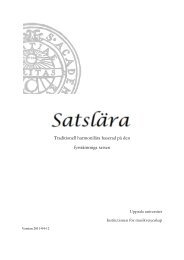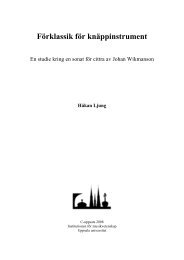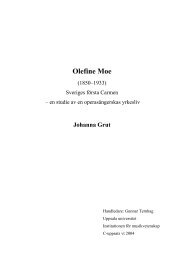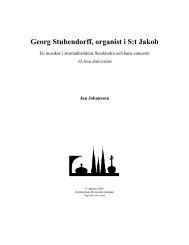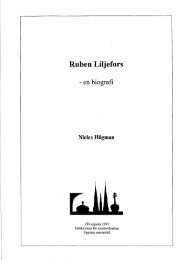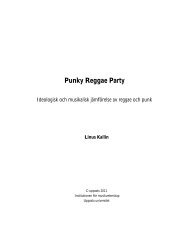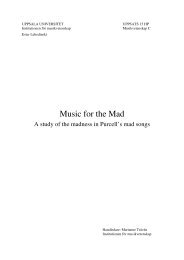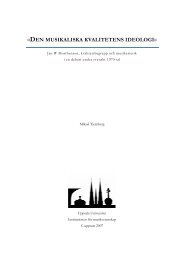What Does Donna Lee Mean? - Institutionen för musikvetenskap ...
What Does Donna Lee Mean? - Institutionen för musikvetenskap ...
What Does Donna Lee Mean? - Institutionen för musikvetenskap ...
You also want an ePaper? Increase the reach of your titles
YUMPU automatically turns print PDFs into web optimized ePapers that Google loves.
assists of James Brown (Bernard Odum, "Sweet" Charles Sherrell, Tim Drummond, Bootsy<br />
Collins, Fred Thomas—to name a few) it wouldn't be long before everyone started<br />
considering funk as the new thing to be doing. Especially if one wanted to sell records, since<br />
funk proved itself an incredible commercial success.<br />
Rocco Prestia<br />
Francis Rocco Prestia is considered by bass connoisseurs a stylist of refined taste and a funk<br />
institution. Among bassists worldwide, he is known for his innovative use of fast, 16th-note-<br />
based grooves behind the five-horn front line of the mythical soul-funk group Tower Of<br />
Power. The band began playing cover versions of tunes by rock groups such as the Beatles<br />
and the Stones, and after a while, the band got hip to soul music and enlisted other horn<br />
players. They started covering the r&b tunes of James Brown, among others. Rocco was<br />
personally inspired by the sounds and feels of James Brown, along with the Motown and<br />
Memphis sounds. Bassists that influenced Rocco included: James Jamerson, Chuck Rainey,<br />
Jerry Jemmott, and Duck Dunn. Through the use of these influences, Rocco invented and<br />
developed his own style of bass playing which would come to be called fingerstyle funk.<br />
The first of many classic Tower Of Power recordings came in the form of<br />
East Bay Grease which was released in 1971 on an independent label. Shortly thereafter, the<br />
band was signed by Warner Bros. Records in 1972 and years of top 40 hits and gold records<br />
followed. The release in 1973 of the album Tower of power helped bassists and musicians<br />
worldwide recognize the talent behind Rocco's innovative 16th-note based lines.<br />
Finger funk style of playing is an essential element of Rocco's technique and<br />
has become a prominent component in the performance of many of today's top bassists. Even<br />
though Rocco seems to be constantly playing a steady stream of 16th-notes, his busy lines<br />
always come from deep inside the groove and never get in anyone's way. It deeply influenced<br />
Jaco when coming up with his own version of fingerstyle funk, which is a step ahead from<br />
Prestia’s one. Let’s analyze this style in more detail: First of all, 16th-note rhythms are the<br />
backbone of fingerstyle funk grooves. It is the constant and continuous stream of 16th-notes<br />
that is the underlying foundation of this style of music. By incorporating ghost notes into this<br />
style, one creates the impression of continuous flow, and because what would be rests of<br />
silent space are filled with the percussive sound of the gost notes, groove is propelled and so<br />
is the overall feel of the music. The following is the main groove on Tower of Power major<br />
hit ”<strong>What</strong> is hip”<br />
9



